Art Heists – A Look at the Biggest Art Museum Heists in History
We can all agree that art has the potential to carry a tremendous amount of value, especially if it is made by a famous artist. Art is a great investment but for some, art becomes an opportunity in a more criminal sense. This article is sure to spark your interest in some of history’s most famous art heists. Read on for an in-depth review of the most intriguing art heists of all time.
Contents
- 1 Top 10 Famous Art Heists in History
- 1.1 The Polish Pirates of 1473
- 1.2 Da Vinci’s Mona Lisa (1503) Snatched From the Louvre (1911)
- 1.3 The Ghent Altarpiece (1432) Panels (1934)
- 1.4 The Quedlinburg Theft (1945)
- 1.5 The Boston Art Museum Heist (1990)
- 1.6 Moderna Museet: An Art Heist Hotspot (1993 – 2000)
- 1.7 Horrors at the National Gallery of Norway (1994) and the Munch Museum (2004)
- 1.8 Van Gogh, Van Gone (1997; 2010)
- 1.9 The Spider-Man Heist at the Paris Museum of Modern Art (2010)
- 1.10 A European Heist Spree: “The World’s Most Consistent Art Thief”
- 2 The FBI’s Most-Wanted: Art Crimes
- 3 Frequently Asked Questions
Top 10 Famous Art Heists in History
It is said that money is the root of all evil and so it appears evident in the history of art heists. Along with fame, also comes monetary value and as a famous artist, you would do well to ensure that your art is in trusted hands or stored safely. Also dubbed “art napping”, art heists quite literally refer to the theft of valuable art from formal, private, institutions such as galleries and museums.
The glamorization of theft in art also features in many popular culture films, which involve fictional stories built around the idea of people planning and plotting to steal various valuable pieces of art from seemingly high-security institutions.
This is usually for some grand cause or a plot twist in the character of the thief. In the real world, many individuals have attempted to steal famous artworks with some people temporarily succeeding and others remaining hidden away and uncaught by investigators. Below, we have a list of some of the world’s biggest art heists to date.
The Polish Pirates of 1473
| Date | 1473 |
| Stolen Artwork(s) | The Last Judgment (1467 – 1471) by Hans Memling |
| Intended Destination | Italy |
| Where It Is Housed | National Museum, Gdańsk, Poland |
Perhaps one of the earliest recorded art heists in history, The Last Judgement (1467 – 1471) by Hans Memling was commissioned by an agent of the Medici family in Bruges but on its way to Italy, the painting was stolen by Polish pirates.
Later, the painting was returned by the pirates to a cathedral in Gdańsk and was later moved to the National Museum.
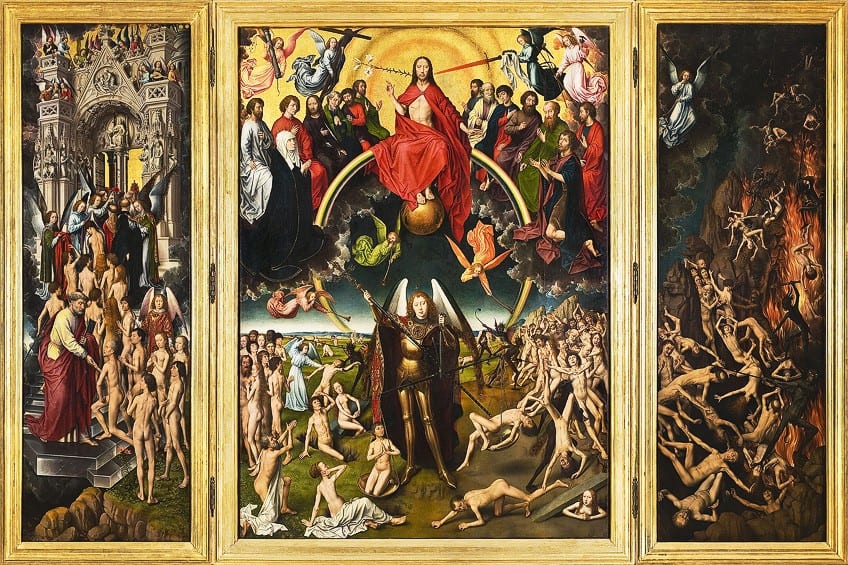
Da Vinci’s Mona Lisa (1503) Snatched From the Louvre (1911)
| Date | 1911 |
| Institution | The Louvre Museum, Paris, France |
| Stolen Artwork(s) | Mona Lisa (1503) by Leonardo da Vinci |
| Estimated Worth | $900 million |
Definitely up on the list of the most famous art heists in history is the theft of the Mona Lisa (1503) on August 21 in 1911. One might even say that this art heist is also on the list of the most successful art heists since the theft, committed by a handyman, Vincenzo Peruggia, was successful in snatching the Mona Lisa from the Louvre Museum in Paris and only caught two years after the robbery occurred.
The story goes that the theft of the Mona Lisa, one of the greatest masterpieces created by Leonardo da Vinci, was what elevated the value of the painting and thereafter, its launch to fame and current status as one of the most valuable paintings in the world.
So, who was the handyman who stole da Vinci’s Mona Lisa? Vincenzo Peruggia was not only an Italian handyman but he was also an artist and a museum worker. According to police theories, it is believed that Peruggia, who was working for the Louvre at the time, hid inside the museum after hours, fully aware that the museum was not open the following day. This was then refuted by Peruggia during his interrogation where he confessed that he had entered the museum at seven in the morning on the Monday, 21st of August.

He waited until the Salon Carré was empty and he lifted the painting off the wall and took the Mona Lisa to a service staircase, where he took off its protective casing and frame. In Peruggia’s interrogation, he stated that he removed his smock and used it to wrap the painting, which he then tucked under his arm and casually exited the museum through the same entrance at which he arrived. This art heist sounds like a plan that ran smoothly, considering the very simple confession of Peruggia. The missing painting soon made headlines and the news of the missing Mona Lisa spread like wildfire across the globe.
Peruggia may have thought that he got away scot-free with a painting that was soon to be the most wanted commodity in the world but he encountered an issue that soon proved his theft a futile act.
Although Peruggia had the painting, he was not able to sell the painting since no one would have wanted to purchase a stolen artwork, most importantly, an artwork that received a great deal of international attention. Peruggia ended up stowing the painting away under the floorboarding of his apartment in Paris, where he later tried to sell the work to another art dealer from Florence. The theft was not as much primarily centered around monetary gain but more so as an act of repatriation, as Peruggia claimed.
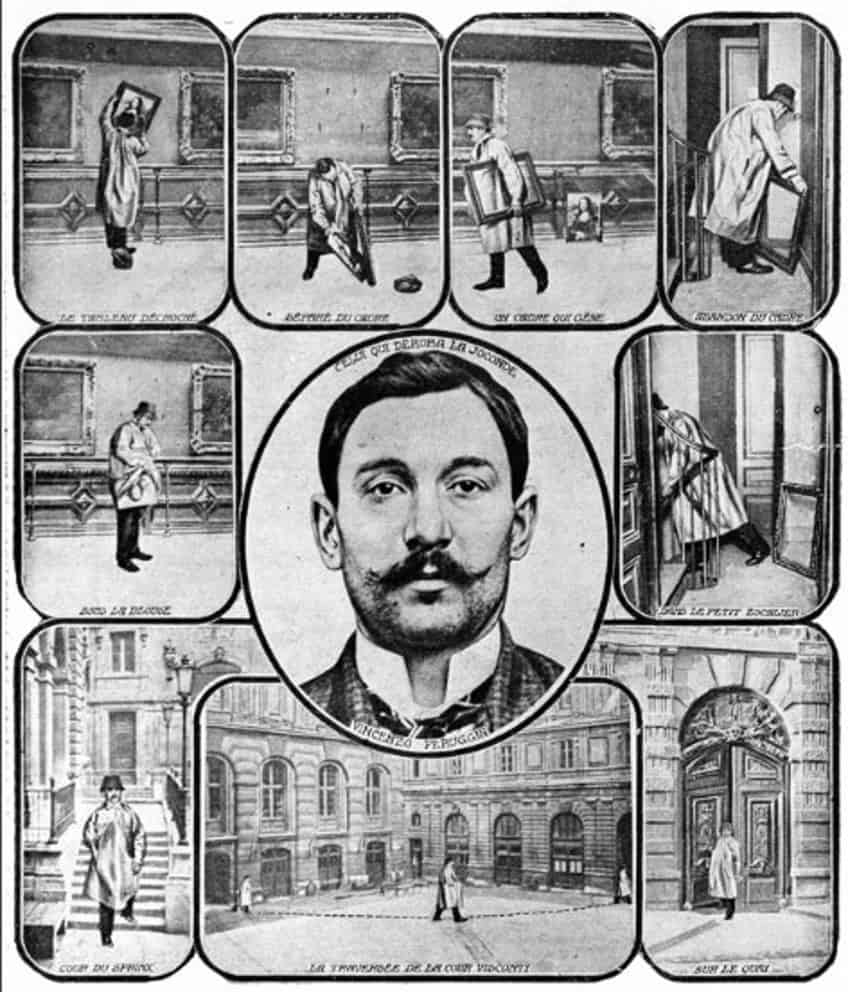
Peruggia was on a mission to take back what he thought was stolen by Napoleon. Was this just an excuse? As an artist, he probably knew of the painting’s maker, da Vinci, and the value that this work could potentially carry. The true acquisition of the Mona Lisa at the Louvre involved the purchase of the work by King Francis I just after the death of Leonardo da Vinci in 1519.
Just when Peruggia thought that he had scored on a potential sale, the art dealer made no haste in contacting the right person, Giovanni Poggi, who was Uffizi Gallery’s director who shortly reported the situation to the police.
If not for the art dealer who brought the Mona Lisa directly to Poggi, Peruggia may have gotten away with it for much longer. Peruggia only served several months in jail, even though he received a longer sentence and thereafter served in the Italian army in World War I. When the war ended, he later married, changed his name to Pietro Peruggia, and went on to become a decorator.
The Ghent Altarpiece (1432) Panels (1934)
| Date | 1934 |
| Institution | St Bavo’s Cathedral, Ghent, Belgium |
| Stolen Artwork(s) | Ghent Altarpiece or The Adoration of the Mystic Lamb (1432) by Hubert van Eyck and Jan van Eyck |
Now dubbed as the most stolen artwork to date, the Ghent Altarpiece (1432) by Hubert van Eyck and Jan van Eyck has been through the most since its creation. The artwork is a polyptych altarpiece executed by the two Netherlandish brothers for St. Bavo’s Cathedral in Ghent, Belgium. The incredibly detailed 15th-century artwork soon faced many tribulations.
Prior to the great art heist that took place before 1934, the artwork encountered around 12 other crimes accompanied by several thefts.
Following the French Revolution, the artwork was also almost obliterated by the Calvinist uprisings, including Napoleon, who had disassembled, stolen, and censored the altarpiece. The artwork then circulated among renegade clerics and was stolen multiple times throughout World War II. The altarpiece was eventually rescued by a few miners, the Monuments Men, and a few double agents. Even the Nazis tried their luck with obtaining the artwork.
Surely you may think that this artwork has seen enough greed and theft. Think again. In 1934, one of the 12 panels was stolen and the case of the missing panel remains unsolved. In April of 1934, the panel was discovered missing and the police Commissioner, Antoine Luysterborghs was on the scene to witness the crowds who could not believe their eyes. The missing panel was the panel that portrayed the righteous judges.
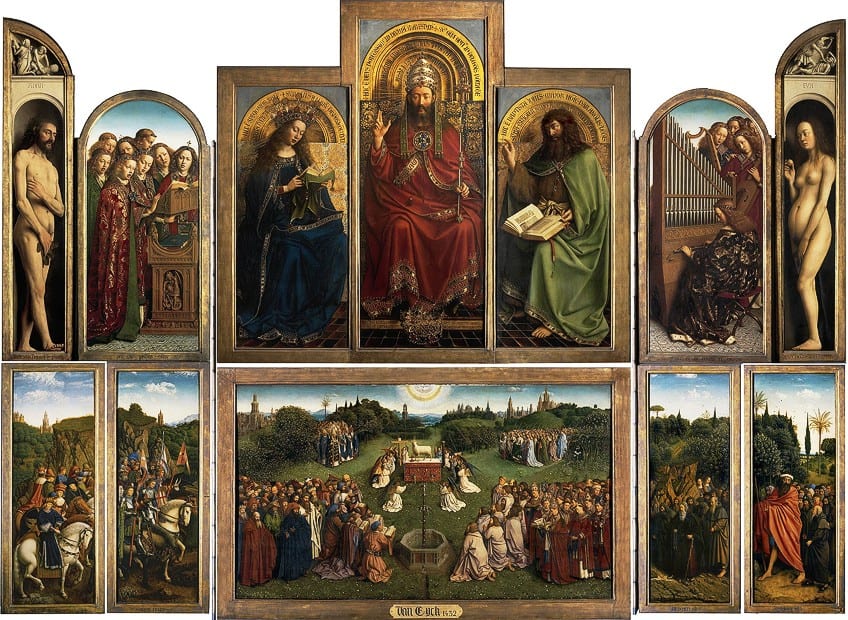
You may assume that there would have been haste considering the fame around the work but it seems as though the Commissioner only took a glance and left the scene to attend to a more pertinent case at the local cheese shop. What ensued next was a plot twist – the thieves soon put out a ransom demand for a total of one million Belgian francs and even went as far as to return one of the panel’s pieces. The police were unable to fathom their next steps.
Not long after, a stockbroker called Arsène Goedertier suffered a heart attack during a political rally and called his lawyer, Georges de Vos to confess that he knew the whereabouts of the Mystic Lamb. This was done on his deathbed of course and he directed his lawyer to his writing table, which held an envelope titled mutualité. The lawyer discovered more carbon copies of the ransom letters in addition to another unsent letter that contained a clue to the whereabouts of the missing panel.
The stockbroker perhaps enjoyed the idea of putting out clues in hope that someone would take the bait but it seemed that no one truly cared about the world’s most stolen painting.
The last note on the location of the painting stated that it was situated in a place where no one could remove it unless attracting a great deal of attention from the public eye. Assuming that it was true that the stockbroker stole the painting, the question of why remains unanswered. It is reported that the church had also been defensive about the issue and suspicion revolves around individuals of the bishopric.
According to one theory, it is said that Goedertier, who was one of the church members, got together with other church members, and the stolen painting was involved in a solution to fix a failed investment scheme, which lost a certain amount of church money. The only concern surrounding this theory was that Goedertier was a well-off man and it is out of place to assume that this would be his last option. Strange, is it not?
Once again, the case dragged on and the stockbroker’s confession was only reported to the police after one month. Talk about a delay in action! The case received many false leads and the police eventually settled on the stockbroker’s confession that he was the true culprit. As for the recovery of the missing panel, it was never found. Progress continues to be made, slowly yet surely by the Ghent police. One man, Karel Mortier, who was the chief of the Ghent police from 1974 to 1991, actively conducted his behind-the-scenes research and investigation around the main suspect.
He pointed out information that alluded to the fact that Goedertier had an eye condition that would not allow him to see in the dark very well, which meant that he would be one of the most unlikely persons to successfully rob a cathedral at night.
Unless he had assistance. The panel was stolen off the framework surrounding the altarpiece, which was high enough off the floor that it would have required a ladder and at least two other individuals to move it. The chief of police concluded that one of the four custodians of the church was probably involved in the art heist since one of them would have had to provide a ladder. As you can imagine, this might have been the best basis for initiating an investigation of the church but Mortier’s investigation also encountered many issues.

Although he was given access to the church’s archives concerning the painting, he was not granted access to records dated between 1934 and 1945, which appeared to allude to a cover-up attempt of concealing the truth. The many downfalls throughout the investigation lead us to believe that perhaps the artwork, after having gone through so much in its history, did not want to be found. Mortier was also upset about the way that the evidence concerning the stockbroker’s notes was handled and fingerprinting was not captured.
The case, at this point, seemed to have gone cold and this lasted for around 10 years. In the midst of World War II, Joseph Goebbels sought out the help of an art detective by the name of Heinrich Köhn to retrieve the missing panel as a gift to Hitler.
According to the art detective, the panel was stowed away on-site but was moved before his arrival. This story aligned with a statement by Goedertier, who had previously mentioned to his wife, who suspected German involvement, that “if they let me search for it, I’d stay in the vicinity of the cathedral”. The chief of police felt that Goedertier’s statement was potentially referring to the church community and not the location of the cathedral. Mortier left for Germany in 1963 and located the art detective’s widow, who let him copy his 176-page notes on the search.
The notes suggested that the art detective was convinced that the last panel was still inside the cathedral and according to the record, in 1942, one of Köhn’s assistants told the bishop that the Germans were planning on closing the cathedral to look for the panel. The bishop had also stated that Gabriel van den Gheyn, another person (and canon) who was responsible for the painting’s safekeeping in World War I, organized the smuggling of the altarpiece in the evening and was stored in private homes until the war came to a halt.
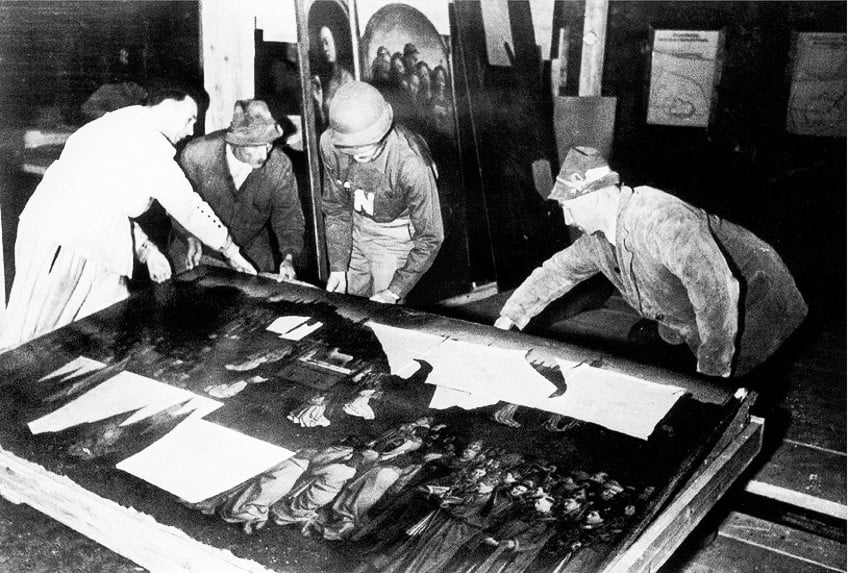
Later on, Mortier found that a Belgian assistant who worked with Köhn said that the panel had already been found by Van Den Gheyn. Although once again unclear as to why the panel remained hidden, clues continued to pour in and Mortier was at one point faced with 350 potential sites to search, with all of them producing no panel.
The cathedral had been searched six times post World War II and had even undergone an x-ray of up to 10 meters underground.
Around 1995, the public continued to take an interest in the case, this time by an illegal excavation of Goedertier’s skull, which was then stolen for a seance. The craze was heightened at this point. DNA tests were performed on the ransom letters in 2004, however, the results were inconclusive. In the end, the attorney general’s office compiled a comprehensive 2000-page case file surrounding the theft.
Today, the Ghent Altarpiece is under the protection of modern technology and is equipped with a bullet-proof glass casing. The artwork had since undergone a major seven-year restoration project and was unveiled to the public in 2021.
The Quedlinburg Theft (1945)
| Date | 1945 |
| Site | Quedlinburg, Germany |
| Stolen Artwork(s) | Multiple art objects and relics; Samuhel Gospel, perfume flask, ivory liturgical comb, and so on. |
| Estimated Worth | +$200 million |
In a successful criminal heist leading up to the end of the second World War in Europe, Quedlinburg faced the tactics of a United States Army Lieutenant called Joe T. Meador. Discovered by the United States Army, a few valuable church objects were found near Quedlinburg in Germany.
Placed under appropriate security, or perhaps not as we might have thought, among the valuable objects was a ninth-century illuminated gospel book called the Samuhel Evangeliar, including a jewel-encrusted book of gospel readings dating back to 1513.
Along with the valuable objects were reliquaries, a rock crystal perfume flask, an ivory liturgical comb, and other artifacts that appeared as though they were irreplaceable. The Quedlinburg Abbey was once a proprietary church for the Ottonian Imperial family, founded by Emperor Otto the Great around 936 in memory of his late father. Over the centuries, the church received a great collection of treasured and precious objects from the Imperial family and after Protestant Reformation, the church was then converted into the Lutheran church of Saint Servatius.

Under the reasoning of security, the treasures were relocated to a mineshaft located southwest of the town during World War II. The cache was discovered in 1945 by the 87th Armored Field Artillery Battalion, where the objects were to be stolen. After a few brief investigations, the case fell away in 1949 and by this time, Quedlinburg fell under Eastern Germany. So why did the Lieutenant of the United States Army steal these precious objects?
Prior to joining the war, Meador majored in art at the North Texas State University, thus equipping him with the knowledge and better standing as someone who would appreciate valuable objects.
According to reports by other soldiers, some men had seen the Lieutenant entering and leaving the mine with “bundles”. Further evidence found in the letters that he wrote to his family indicated that he mailed around several historical objects to his home in Whitewright, Texas. Although this is not much of a planned and staged heist, this theft did cause quite a stir much later. Meador also did not hide the fact that he had the objects. He allegedly did not attempt to sell the works but did show some of his colleagues his prized “possessions”.
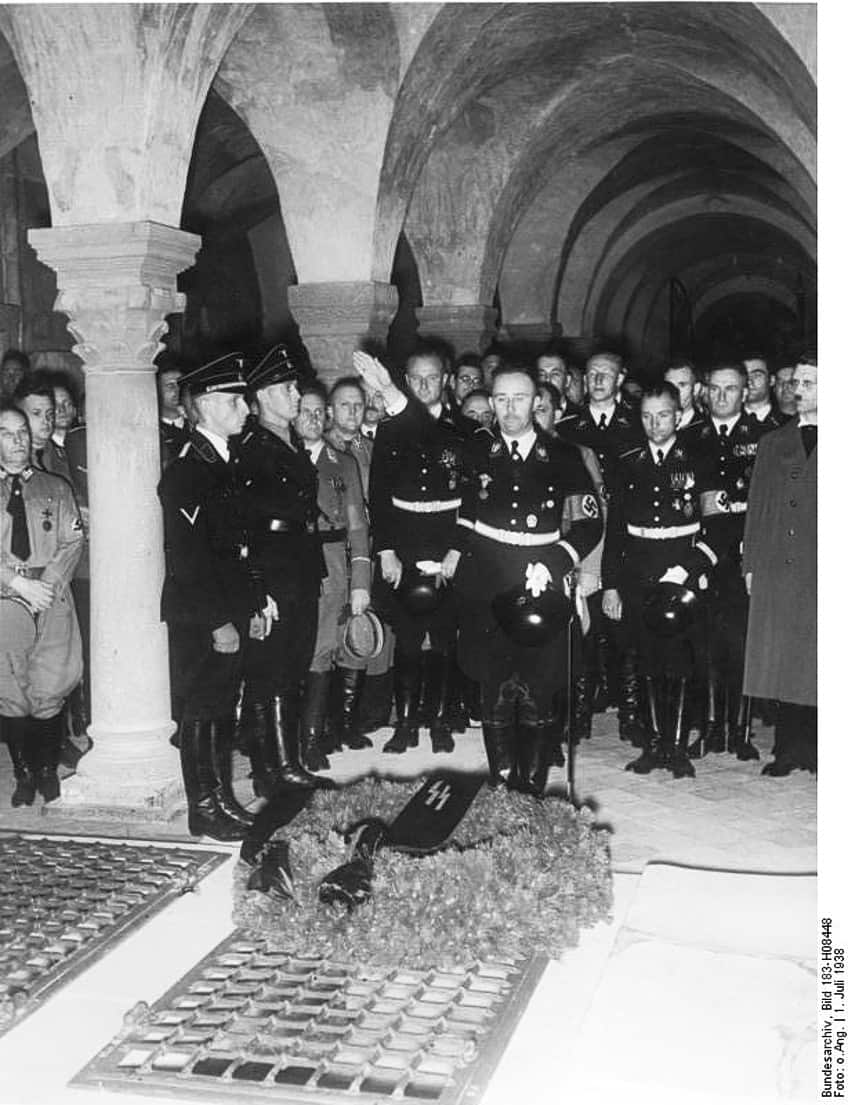
Meador passed away in 1980 but left no mention of the precious art objects in his will. Perhaps in an attempt to correct the past injustice, Meador’s siblings sold the Samuhel Evangeliar for $3 million in 1990 to the Cultural Foundation of the States, which was based in Berlin and centered around the repatriation of German art. The sale attracted the attention of the U.S District Court and resulted in a civil lawsuit on behalf of the church. The Meador family received $2.75 million for coming forward and returning the stolen goods.
The United States government also chose to follow through with charges against the family for conspiracy to “receive, possess, conceal, store, barter, sell, and dispose of stolen items”.
This charge also fell through since the District Court ended up dismissing the case due to the case being brought up too late as per the statute of limitations, which expired. Following this, the Meador family was caught up in an investigation headed by the Internal Revenue Service, which was settled for $135,000.
The Boston Art Museum Heist (1990)
| Date | 1990 |
| Institution | Isabella Stewart Gardner Museum, Boston, Massachusetts |
| Stolen Artwork(s) | Chinese Gu (12th century); Rembrandt van Rijn: Christ in the Storm on the Sea of Galilee (1633); A Lady and Gentleman in Black (1633); Portrait of the artist as a Young Man (c. 1633); Landscape with an Obelisk (1638) by Govaert Flinck; The Concert (1663 – 1666) by Johannes Vermeer; Edgar Degas: Leaving the Paddock (c. 19th century); Procession on a Road near Florence (1857 – 1860); Study for the Programme (1884); Study for the Programme De La Soirée Artistique Du 15 Juin 1884 (1884); Three Mounted Jockeys (1885 – 1888); Eagle Finial (1813 – 1814) by Pierre-Philippe Thomire; and Chez Tortoni (1875) by Édouard Manet |
| Estimated Worth | +$500 million |
Known as the world’s largest art heist in history and the art heist that involved the most valuable piece of stolen art, the Isabella Stewart Gardner Museum saw 13 artworks missing on the morning of March 18th, 1990. Before the robbery, the Federal Bureau of Investigations also uncovered information that alluded to the museum being a target for local Boston criminals in 1982 and was advised to implement better security measures. The museum did implement as many security measures as their funding allowed, however, this did not seem to be enough for the tactics of Boston’s criminal art lovers.
The heist took place in the early morning of Sunday, March 18, and there were even reported witnesses who claimed to have seen the thieves in the area before the heist ensued.
Disguised as police officers, two men lay in waiting in a car on Palace Road, carefully parked close to the museum’s side entrance. At the time, the witnesses assumed these to be actual police officers. Two guards were on duty taking turns to execute their watch rounds and during the evening, there seemed to be a malfunction and one of the guards had to reset the security panel and check the side entrance door. To the guard’s surprise, he found the two “police officers” who he did not think would later subdue both his colleague and himself to commit one of the greatest heists in art history.

The guards had been fooled and they soon had their heads and hands duct taped and tied up downstairs in the museum’s basement. It took the thieves less than 15 minutes to get past the security and make sure no one else was in the way of their operation. Talk about a professional and efficient heist. Over the next hour, the museum was looted. Among the works stolen were works by Rembrandt van Rijn, Johannes Vermeer, a work by Édouard Manet, a few works by Edgar Degas, and an ancient Chinese bronze vessel.
This heist was known to be the highest-valued robbery of 2000 that carried a missing artwork value of $600 million.
Among the paintings stolen, The Concert (1663 – 1666) by Johannes Vermeer is known as the most valuable piece of stolen art to date, with an estimated value of over $250 million alone since its last evaluation in 2015. How the thieves handled the artwork while removing them from their frames only proved that they were not particularly trained in the field of art heists. What was also interesting is that the thieves also paid no attention to the most valued painting at the museum, The Rape of Europa (1560 – 1562).
The museum put out a $10 million reward for any information about the recovery of the stolen artworks and was noted as the most extensive reward offering ever offered by a private institution. The Federal Bureau of Investigation suspected that the heist was executed by a criminal organization and while they lacked a lot of physical evidence, they only had reliance upon informants, interrogations, and sting operations to deduce profiles.
The key suspect of the case was the Boston Mafia, who were also going through an internal gang-related war during the time. One of the theories around the heist suggests that the late gangster, Bobby Donati arranged the heist for negotiation for his caporegime’s release.
Other theories state that the heist was executed by other gangs in the Boston area. The Boston art museum heist received a great deal of attention and international publicity, which continues to spark the interest of aspiring art heist sleuths. All suspects in the case denied any knowledge of the heist, regardless of the reward. The case of the missing artworks remains a mystery along with the true identities of the thieves. Where in the world could they be and who robbed the Gardner Museum? The Netflix documentary on the Gardner robbery, This Is a Robbery: The World’s Biggest Art Heist (2021) also contains useful insights into the case.
Moderna Museet: An Art Heist Hotspot (1993 – 2000)
| Date | 1993 – 2000 |
| Institution | Moderna Museet, Stockholm, Sweden |
| Stolen Artwork(s) | Artworks by Pablo Picasso, Georges Braque, Rembrandt van Rijn, Pierre-Auguste Renoir, and Henri Matisse. |
| Estimated Worth | +$52 million |
Sweden has also faced the unfortunate hand of conniving art thieves. In 1993, the Moderna Museet lost several paintings and a sculpture by Georges Braque and Pablo Picasso. According to reports on the incident in 1993, the robbery took place in the evening and was undetected until the morning, when the security guard discovered a hole in the roof, which was used as the thieves’ entrance.
Not long after, a national search for the paintings and sculpture took place with the museum chief, Bjorn Springfeldt stating that the thieves had “ripped the heart out of the exhibition”.
The stolen paintings were state-owned and uninsured. The theft of the Picasso and Braque paintings also caused a rift between the government and members of the Museum since many complained that the government’s call to minimize funding for security is what contributed to the heist. Approximately several years later, another large art heist occurred at the National Museum in Stockholm. This time, the thieves were armed with a submachine and employed various distractions to make their big break-in and get away from the scene unsuspected.
Three works went missing in this heist, including works by Pierre-Auguste Renoir and Rembrandt, which were both valued at around $30 million. The police executed a drug raid in 2001 and to their surprise, also found one of the missing Renoir artworks.
Fast forward a few years later, international authorities on a Bulgarian syndicate case caught the accused attempting to sell off one of the missing Rembrandt paintings for $42 million.
In 1987, a Henri Matisse painting was also snatched up from Sweden’s Museum of Modern Art but was returned almost 25 years later with no clues as to the whereabouts or identity of the thieves who committed the crime. The stolen work was Le Jardin (1920), which is probably worth well over $1 million by now. According to reports on the incident in 1987, the robbers broke in using a sledgehammer during the early hours of the morning. The painting was flagged after it had been found by an art dealer who ran the painting through the Art Loss Register, which is a global database listing stolen art and is a standard procedure for any sale.
Horrors at the National Gallery of Norway (1994) and the Munch Museum (2004)
| Date | 1994, 2004 |
| Institution | The National Gallery of Norway and Munch Museum, Oslo |
| Stolen Artwork(s) | The Scream (1893) and The Scream (1910) by Edvard Munch |
| Estimated Worth | +$119.9 million |
Not once but twice, The Scream by Edvard Munch is popular in art heist history for being stolen – twice. In February of 1994, Munch’s famous screaming man, The Scream of 1893 was stolen from the National Gallery. The thieves swiftly used a ladder and broke in through a window to grab the painting and get away just as quickly as they came in.
They even left a note of sarcastic gratitude saying “thanks for the poor security”. The museum heist took a total of 50 seconds to execute.
A month later, a ransom demand of $1 million was published and a sting operation was organized to retrieve The Scream (1893). In 1994, the painting was successfully recovered and the four criminals were arrested but later released due to legal grounds. The leader of the group charged with the heist was Pål Enger, who received a sentence of six years and four months. Turns out, the group leader was also responsible for the theft of Edvard Munch’s 1895 painting, The Vampire. Perhaps in an act of penance, Enger later purchased a legitimate lithograph by Munch at an art auction in 2001 – a die-hard fan indeed.

This is perhaps one of the most daring museum heists in art heist history. While many of the world’s most famous art heists occurred at strategic hours, usually long before you may even start getting ready for the day, this art heist will have you in as much shock as seen in The Scream (1910), the second version of the original scream portrait, which was snatched in broad daylight alongside Madonna (1894) in 2004.
The paintings were both taken by two masked men armed with guns but were photographed in action, exiting the Munch Museum during their “getaway” by a quick-thinking witness.
In 2006, six men faced trial for the robbery and were sentenced to a maximum of eight years in prison. In August of that same year, the paintings were retrieved by police and were put on display immediately at the Munch Museum for the public to witness, of which 5,500 people attended.
Van Gogh, Van Gone (1997; 2010)
| Date | 1997, 2010 |
| Institution | Mohammed Mahmoud Khalil Museum, Cairo, Egypt |
| Stolen Artwork(s) | Poppy Flowers (1887) by Vincent van Gogh |
| Estimated Worth | $55 million |
According to the records, a minimum of 13 Van Gogh paintings have been stolen, many of which have been recovered but only one has been stolen twice. This time it is not a different version of the same painting but it is the same painting itself that faced the hands of heist professionals in 1977 and 2010.
An oil still life by Vincent van Gogh made in 1887 went missing from the Mohamed Mahmoud Khalil Museum in Egypt in 1977. The painting, Poppy Flowers, was not to be found until 10 years later in Kuwait.
The museum was not new to robberies and returns since one robbery involving nine paintings was later stolen from the museum but the paintings were found only 10 days later, dumped outside of the institution. The second attempt at the Poppy Flowers was made in 2010 but this time, officials were unable to find any leads and the 30- by 30-centimeter painting is missing to this day. On the day of the heist, approximately nine people entered the museum and the painting was somehow cut from the frame and carried out of the museum.

The robbery was an easy job since none of the security features were in working order. You might think that a Van Gogh painting would have at least had top-notch security measures but unfortunately, the entire museum experienced a case of “poor security”.
A reward of $175,000 by the billionaire Naguib Sawiris still remains for anyone who may have direct information on the location of the painting.
The Spider-Man Heist at the Paris Museum of Modern Art (2010)
| Date | 2010 |
| Institution | Paris Museum of Modern Art (Musée d’Art Moderne de Paris), Paris, France |
| Stolen Artwork(s) | La Pastorale (1905) by Henri Matisse; L’Olivier Près de l’Estaque (1906) by Georges Braque; Dove with Green Peas (1911) by Pablo Picasso; and other paintings by Amedeo Modigliani and Fernand Leger. |
| Estimated Worth | +€500 million |
Among the most stolen artworks by famous artists are artworks by Pablo Picasso, as found in the Art Loss Register. The highly recognizable artwork, Dove with Green Peas (1911) was among a total of five important paintings stolen from the Musée d’Art Moderne de la Ville de Paris in 2010.
Included in the thief’s selection were works by Henri Matisse, Georges Braque, Amedeo Modigliani, and Fernand Leger.
According to reports, the culprit, Vjeran Tomic, had visited the museum frequently throughout the year and on his planned evening around three in the morning, Tomic broke in through a window. When Tomic visited the museum, he was not just scouting for a way in. You can say that his heist was one in the making. During his many trips, it seemed that he sprayed acid on the window, which was soon to be his gateway to pulling off one of Paris’ biggest art heists.
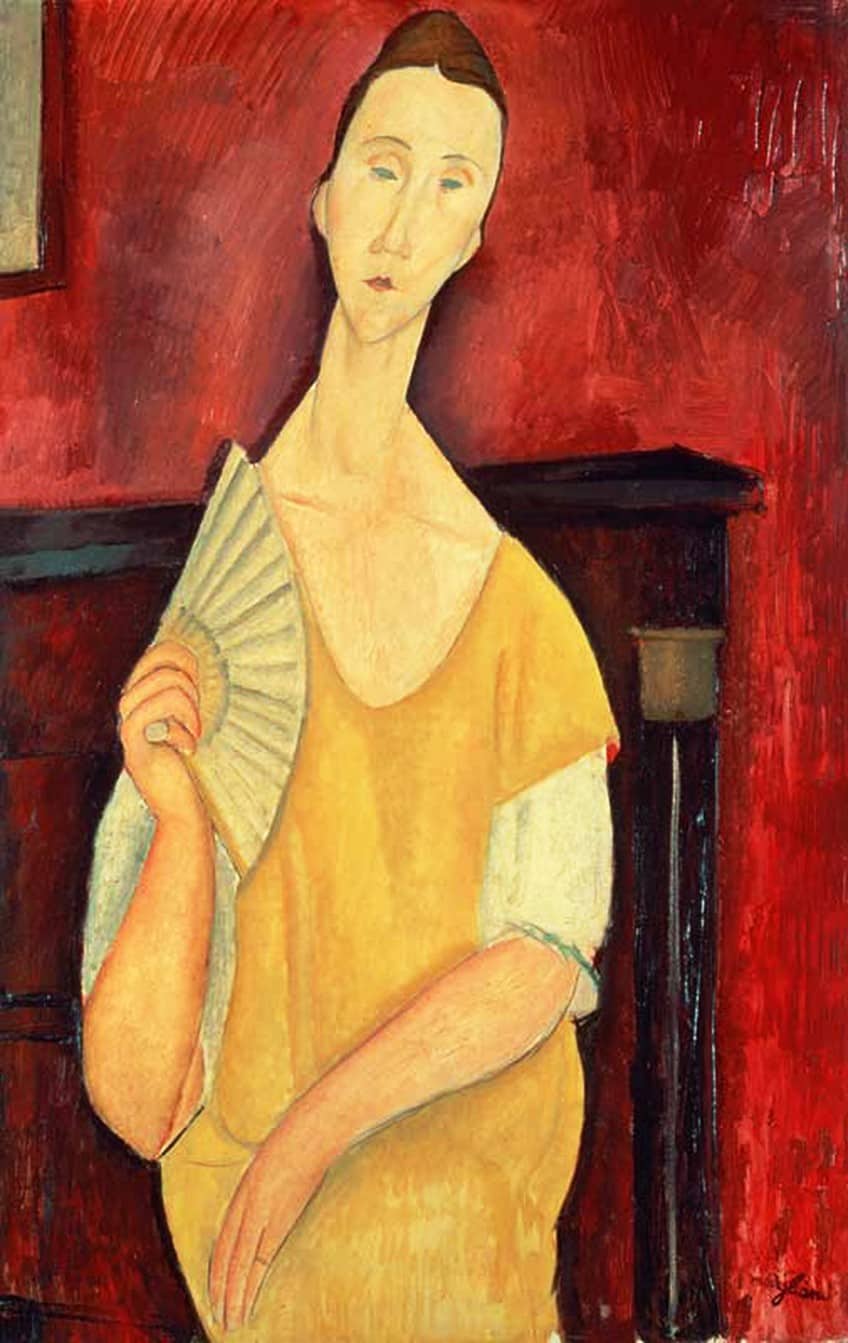
It is believed that Tomic was initially after Matisse’s La Pastorale (1905) but saw that the alarms did not go off and decided to take along the four other works. Tomic was discovered to have been in cahoots with a dealer named Jean-Michel Corvez, who was meant to sell the works. Tomic was eventually caught and received a prison sentence of eight years.
This was not the first time Tomic stole something. His history of heists began when he was just 10 years old, and he even stated that his ability to steal was “intuitive”.
At one point in his teen years, he even claimed that his actions were driven by “invisible forces”. According to the burglar, he even had a dream that he would steal five paintings. Less so documented than the actual art heist, the profile and nature of the character behind the crime is also something that may shock you. According to reports by his close friends and those who knew of Tomic, he was described as both “brutal” and “wild”, and a lover of the fine arts. He was inspired by many Impressionist artists and often admired that which he did not possess, including a happy childhood.
Tomic was a high achiever in school and also an athlete. His history of crimes ranged from selling drugs to violent thefts, death threats, and the possession of illegal weapons. His taste in passions was also described as “charming” and “poetic” and included classical music, animals, fashion, and finer aesthetics. Sound familiar?
This just goes to show that almost any personality is inclined to fall for the romantic nature of executing an art heist.
A European Heist Spree: “The World’s Most Consistent Art Thief”
| Date | 1991 – 2000 |
| Institution(s) | +200 museums, including: Medieval castle in Gruyeres, Switzerland, and another castle in Baden-Baden, Germany. |
| Stolen Artwork(s) | 239 artworks by multiple artists |
| Estimated Worth | +$1.4 billion |
Averaging approximately one art heist per 15 days, Stéphane Breitweiser is known as the world’s most-wanted art thief. Breitweiser admitted to stealing a total of 239 artworks across an estimated 172 – 200 museums across Europe. Having amassed quite the reputation, this connoisseur began his journey into art heists in 1995 and was eventually caught in 1997 and later in 2001, for stealing a 1584 bugle from the Richard Wagner Museum in Switzerland. His romantic partner in crime, Anne-Catherine Kleinklauss, played her role as the lookout while Breitweiser executed his heists.
It appeared that Breitweiser stole for the purpose of self-pleasure and taking pride in knowing that he secretly pulled off these heists to obtain some of the world’s most valuable paintings.
He stored away many of his stolen goods at his mother’s residence located in Mulhouse in France and strategically kept the artworks in a room with low sunlight, to avoid unnecessary damage. Out of his massive collection, only 110 artworks were recovered while 60 were presumed to be destroyed. In an attempt to cover up her son’s crimes, Breitweiser’s mother also destroyed many works. Among his treasured “Ali Baba’s cave”, were artworks such as Cheat Profiting from his Master by Pieter Brueghel the Younger, which eventually faced the panic of Breitweiser’s mother who cut the artwork up with scissors.
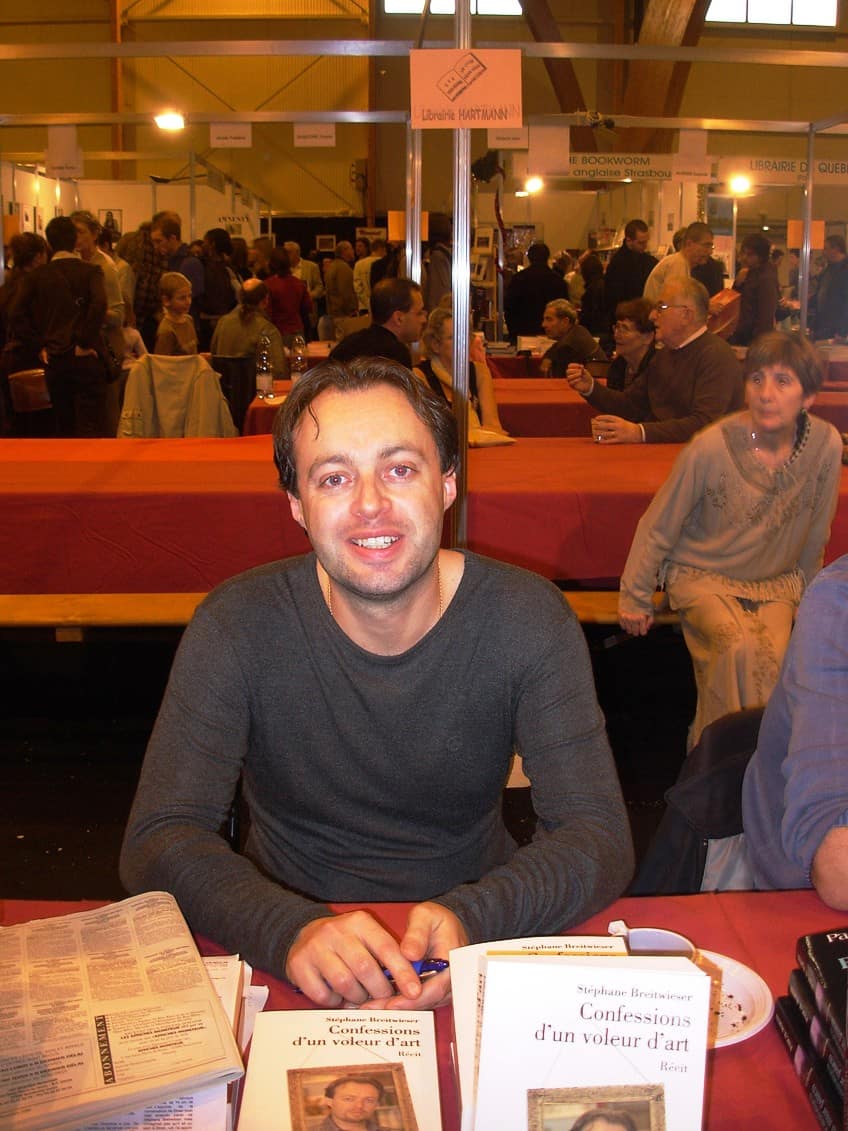
In 2005, the art heist connoisseur was sentenced to three years imprisonment but only served 26 months. His mother was also prosecuted to serve three years and before his release, Breitweiser also attempted to commit suicide by hanging. After being released, Breitweiser went on to publish an autobiography, Confessions d’un Voleur d’art (2006) but one can say that once an art thief, always an art thief – not too long after, in 2011, police conducted a house search and discovered 30 additional stolen artworks, for which he was sentenced to another three years in 2013.
You would think that this was the end of his art heist streak – wrong! In 2019, Breitweiser was at it again after being placed under surveillance.
It was found that he was attempting to sell a paperweight on eBay, which was a stolen object from the museum in St. Louis. The police executed another search of his home and discovered Roman coins, as well as other artworks from other museums.
The FBI’s Most-Wanted: Art Crimes
In 2005, the Federal Bureau of Investigations published a most wanted list outlining their top 10 stolen artworks in an attempt to garner the attention of the public and help catch any suspects. Below are just a few crimes that made the top of the FBI’s most wanted list of art crimes.
Looting of the Iraq National Museum
In 2003, the Iraq National Museum faced a major downfall as around 10,000 precious artifacts went missing. Although many have been returned, there are just as many still missing. Around 2005, the FBI recovered eight cylinder seals, and in 2006, one of the artifacts – a statue of Entemena of Lagash – was returned to the Iraqi government.
A ceremony was held for the occasion, since this was one of the most treasured pieces of the museum.
Theft of Nativity with St. Francis and St. Lawrence (1609)
Missing since 1969, this painting by Italian artist Caravaggio was stolen by two individuals who removed the painting from its frame. The painting carried an estimated value of $20 million and remains missing to date. The FBI, along with the Italian police and Interpol, have all collaborated on finding leads and many theories exist, including those that suggest that the painting may have been destroyed in the 1980s.
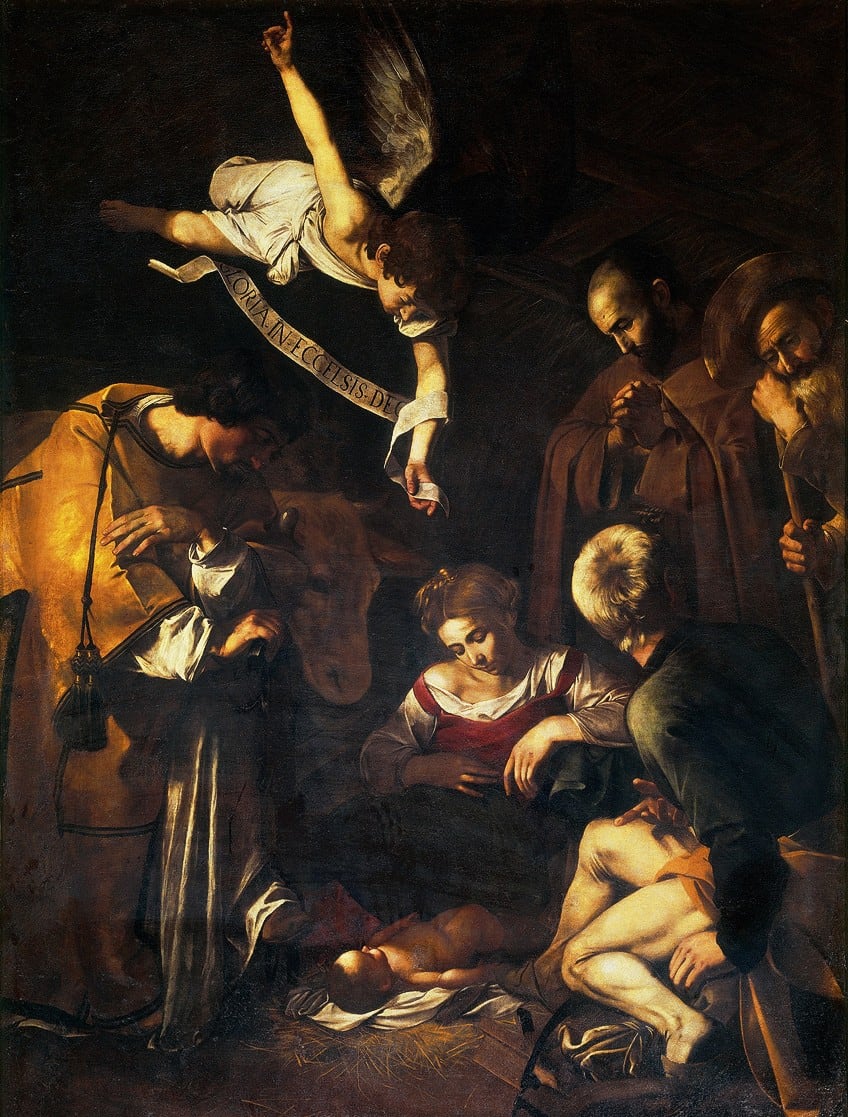
$3-Million Davidoff-Morini Stradivarius Violin
Crafted by Antonio Stradivari in 1727, this musical artifact was stolen from the home of its owner, Erica Morini in 1995 from her apartment in New York City, United States. The violin artifact carries a whopping estimated value of $3 million.
Unfortunately, Morini never knew of the crime since she was in hospital, soon to pass.
Missing Paintings at the Vincent van Gogh Museum
In a mere few minutes on a random day in December 2002, two Van Gogh paintings were stolen from the Vincent van Gogh Museum in Amsterdam. Valued at around $30 million, the two missing paintings were View of the Sea at Scheveningen (1882), which was one of Van Gogh’s earliest works, and Congregation Leaving the Reformed Church in Nuenen (1884). Luckily, during an operation titled Vincent, the police recovered both the paintings, which were found at the home of an Italian mob member. The paintings were found wrapped in sheets, hidden in a wall.
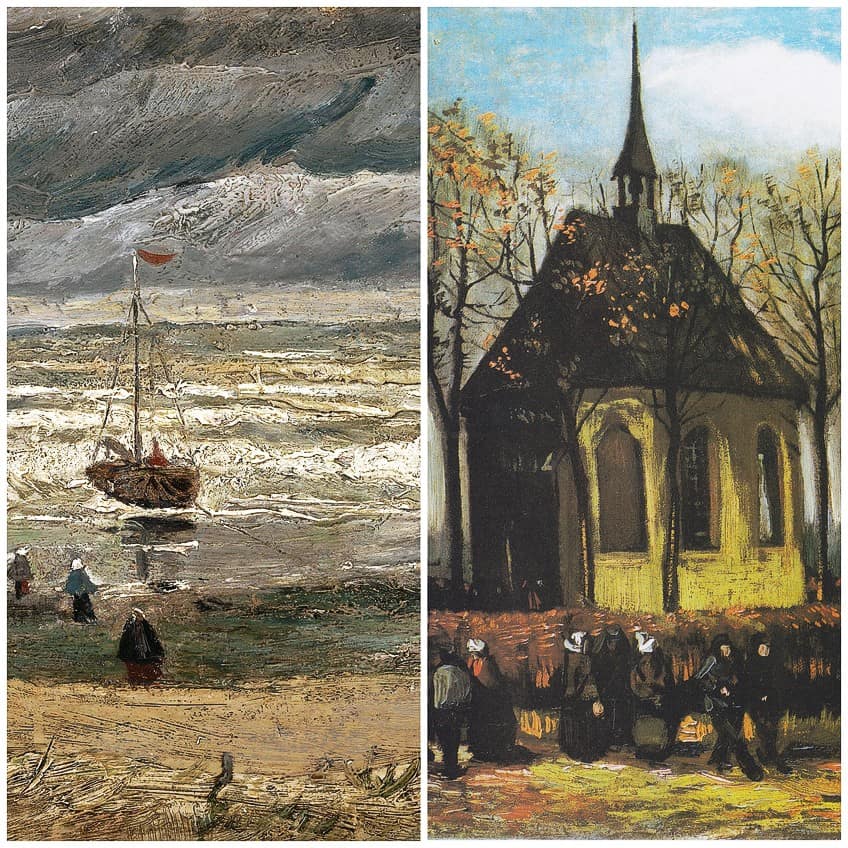
According to statistics, 95% of cases involving stolen art appear to never return to their country of origin and approximately over 50,000 artworks are stolen each year. Some of the most recent high-profile art crimes involve the theft of a Van Gogh artwork from the Netherland’s Singer Laren Museum in 2020. While the emergence of the pandemic has forced the occurrence of art heists to decline, many criminals have resorted to creative means to supply the demand that still exists. Other art crimes that include cultural property thefts have also “flourished” during the pandemic.
Frequently Asked Questions
Who Is the Most Wanted Art Thief?
The most-wanted art thief is Stéphane Breitweiser, who is also known as the greatest art thief of all time, setting his criminal record of robbing close to 200 museums and confessing to stealing around 239 pieces of art.
What Is the Most Valuable Piece of Stolen Art?
The most valuable piece of stolen art is a painting by Johannes Vermeer titled The Concert, which was executed in 1664 and stolen in 1990. The painting was stolen during one of the biggest art heists in the world at the Isabella Stewart Gardner Museum in Boston, Massachusetts, and is valued at $250 million.
Who Robbed the Gardner Museum?
It is unclear as to the identities of the two individuals who robbed the museum. Among the accused were Bobby Donati and Robert Gentile, however, no one has been imprisoned due to the lack of evidence and information on other suspects.
What Was the Largest Art Heist in History?
The largest art heist in history is the Boston art museum heist at the Isabella Stewart Gardner Museum in 1990, which involved two unidentified individuals who stole around $500 million worth of artworks by Rembrandt van Rijn, Edgar Degas, Johannes Vermeer, Édouard Manet, Pierre-Philippe Thomire, Govaert Flinck, and an ancient Chinese artifact.
Jordan Anthony is a Cape Town-based film photographer, curator, and arts writer. She holds a Bachelor of Art in Fine Arts from the University of the Witwatersrand, Johannesburg, where she explored themes like healing, identity, dreams, and intuitive creation in her Contemporary art practice. Jordan has collaborated with various local art institutions, including the KZNSA Gallery in Durban, the Turbine Art Fair, and the Wits Art Museum. Her photography focuses on abstract color manipulations, portraiture, candid shots, and urban landscapes. She’s intrigued by philosophy, memory, and esotericism, drawing inspiration from Surrealism, Fluxus, and ancient civilizations, as well as childhood influences and found objects. Jordan is working for artfilemagazine since 2022 and writes blog posts about art history and photography.
Learn more about Jordan Anthony and about us.
Cite this Article
Jordan, Anthony, “Art Heists – A Look at the Biggest Art Museum Heists in History.” artfilemagazine – Your Online Art Source. September 15, 2022. URL: https://artfilemagazine.com/art-heists/
Anthony, J. (2022, 15 September). Art Heists – A Look at the Biggest Art Museum Heists in History. artfilemagazine – Your Online Art Source. https://artfilemagazine.com/art-heists/
Anthony, Jordan. “Art Heists – A Look at the Biggest Art Museum Heists in History.” artfilemagazine – Your Online Art Source, September 15, 2022. https://artfilemagazine.com/art-heists/.



